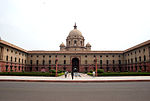Cathedral Church of the Redemption
1931 establishments in India20th-century churches in IndiaBaroque architecture in IndiaCathedrals in New DelhiChurch of North India cathedrals ... and 5 more
Churches completed in 1931Churches in New DelhiRenaissance Revival architectureTourist attractions in DelhiUse Indian English from February 2017

Cathedral Church of the Redemption, also known as the Viceroy Church, is a church in New Delhi, India, that was built between 1927 and 1931. The church is located east of Parliament House and Rashtrapati Bhavan, formerly Viceroy House, which was used by then British Viceroy. The Cathedral Church of the Redemption India, is a part of the Delhi diocese of the Church of North India (CNI)The Church derives its name from Palladio's Church of Il Redentore in Venice.
Excerpt from the Wikipedia article Cathedral Church of the Redemption (License: CC BY-SA 3.0, Authors, Images).Cathedral Church of the Redemption
Church Road, New Delhi Rakab Ganj (Chanakya Puri Tehsil)
Geographical coordinates (GPS) Address Nearby Places Show on map
Geographical coordinates (GPS)
| Latitude | Longitude |
|---|---|
| N 28.618038 ° | E 77.201978 ° |
Address
The Redemption Protestant Cathedral
Church Road
110004 New Delhi, Rakab Ganj (Chanakya Puri Tehsil)
Delhi, India
Open on Google Maps









